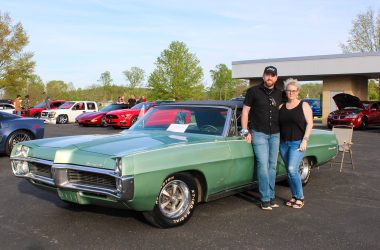Editor’s Note:
The railroad underpass in Hurricane is the only such underpass in Putnam County. The full story of how and why it came to be has escaped history. The following article documents a portion of its history which is certainly known. The article was first published in History of Hurricane Continued 1994.
The Underpass
We were terribly inconvenienced during the brief time required to build the new bridge in Hurricane in 1992-93. One wonders what would have happened if it were not for the underpass. This barely two-way passage between Main Street and Putnam Avenue has received little notice in recounting Hurricane’s history.
Folk lore tells us that during construction of the railroad, many of the workers spent their weekends frequenting local saloons. Authorities would arrest and jail them making a short work force on Monday. Bribery was a known behavior then, so those in charge promised to build the underpass if the workers were promised their freedom for revelry. So the story goes.
There are a few folks around who remember riding a horse-drawn buggy to visit on the “other side of the tracks.” The driver applied the switch to hasten the trip lest a train come through and spook the horse.
This nondescript passage took on new meaning when train car loads of lime were shipped in for area farmers and unloaded at the underpass. Fred Coleman remembered his father hauling lime from this site to the farm on Peach Ridge.
If getting lime unloaded or getting through was essential, you just might make it. However, there was a period when the underpass was treacherous. One citizen, Curtis Rumbaugh, resorted to the pen instead of a sword.
The subject here is UNDERPASS,
The aim is civic pride;
The duty is clean it out
So taxpayers can ride.
We do not want to seem uncouth;
Let fairness be our goal.
We humbly ask our councilmen
To fix this dangerous hole.
We see a horse that prostrate lies
Because of ice and snow;
We help his driver get him up
So he can try to go.
And there’s the cars with broken springs
And fenders dented, too.
We pay the bills but won’t forget
The job that you should do.
Now just in case suit should arise
For damage thus sustained,
Could you present an honest fight
And try the case to gain?
When just a load of CINDERS
Or SAWDUST from the mill
Would help your own constituents
Get up the slippery hill.
The widely circulated poem evidently worked because the next poem was found in his treasures.
Greetings to our Mayor
And councilmen of class
As we view with admiration
Our city underpass.
We want to thank the State Road crew
Who lent a helping hand
With Uncle Jodie Coyner
Our good old section man.
This goes to prove what can be done
When good men get better
They can lick the very toughest job
In any kind of weather.
Now you boys stick together
And give that Guy the boot,
Who’s trying with his darndest
To close the loading chute.
This chute should be kept open
To serve our farm relations.
It is a service in this town;
A real accommodation.
So thanks again. I’ve only tried
A little fun to give.
Let’s all join hands. Make Hurricane
A better place to live.
By 1942 a young entrepreneur, Ernest Cummings, had signed on with a division of the U. S. Department of Agriculture to deliver lime to a five-county area. He built a proper chute and used trucks instead of wagons.
The big problem at this time was water gathering and standing from one rain ‘til the next. Nay-sayers said it couldn’t be drained. There was no place for the water to go. The city gave Judd Craddock a contract to drain and improve the surface which he did to the satisfaction of the city and underpassers.
There is no chute to unload lime, no holes to stop your car. The underpass is still an integral part of Hurricane with a stop sign on the north end, a yellow line down the middle and only a few pigeons darting about overhead.
Post Note:
If and when the history of Hurricane is updated, the events of February 23, 2014, should be included.
On that date truck driver David Paul Sexton of Mississippi discovered that his 18-wheeler was barred from taking Lynn Street to get to Virginia Avenue. Turning to his GPS for advice, he identified what appeared to be an alternate route to U. S. Foods via Putnam Avenue. He turned onto Main Street and drove past the Fire Department to the intersection of Main Street and Putnam Avenue. He soon discovered that this route was blocked by the 11-foot clearance at the railroad underpass.
Rather than backing up on Main Street, Sexton attempted to drive his truck through an alley behind Atelier Inge, an art gallery and gift shop owned by Inge Klein. He thought he could drive around the structure and pass between it and another building, which was being used by Charlotte Henson as a storage facility at that time. The truck struck the corner of Atelier Inge and sank into the soft ground adjacent to the paved alley, causing his radiator to spring a leak. Sexton did not call for help, and the truck was stuck between the two buildings for most of the day.
Klein when discovered that there was a semi stuck in the alley between her store and the building owned by Charlotte Henson. She called the police to report the matter.
After the 18-wheeler’s radiator was repaired, workers from Hurricane Wrecker winched the tractor-trailer back onto solid ground. Sexton tried to pull back onto Main Street, but he accidentally ran over Charlotte Henson’s front porch in the process. The truck hit one of the posts and tore off the porch roof, causing thousands of dollars of damage to the structure.



